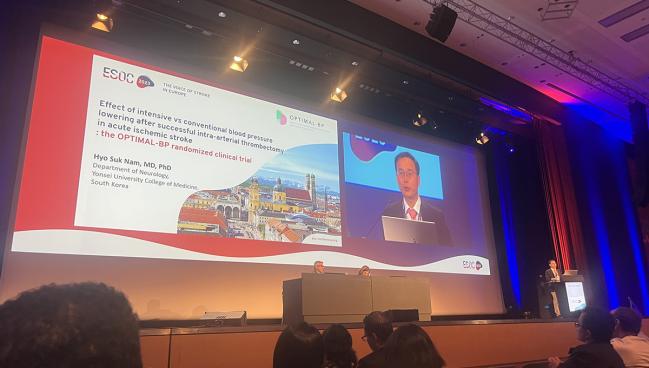OPTIMAL-BP Shows Harm of Too Much BP-Lowering After Stroke Thrombectomy
The trial bolsters ENCHANTED2/MT and suggests it’s better to not be too aggressive after a mechanical intervention.

MUNICH, Germany—Another trial has shown that intensive lowering of blood pressure after successful mechanical thrombectomy worsens functional outcomes in patients with acute ischemic stroke.
In OPTIMAL-BP, aiming for a systolic pressure under 140 mm Hg in the 24 hours after the procedure reduced the likelihood of having a favorable modified Rankin Scale (mRS) score at 3 months compared with conventional management, which allowed for readings of up to 180 mm Hg in that postprocedural period, Hyo Suk Nam, MD, PhD (Yonsei University College of Medicine, Seoul, South Korea), reported last week at the European Stroke Organisation Conference (ESOC).
That finding is consistent with results of the ENCHANTED2/MT trial, but at odds with prior observational data suggesting that lower BP goals might be better.
As for why going too low with BP would be harmful, Nam said, “Despite recanalization, some areas in the ischemic brain may have already been damaged or remained in an oligemic state within the penumbra zone. In these areas, limited autoregulation may not effectively counteract the sudden drops in BP. Thus, intensive BP-lowering may further reduce blood flow to the oligemic area and exacerbate the ischemic injury.”
Overall, he said, “our trial does not support intensive BP management within the first 24 hours after [intra-arterial thrombectomy]; however, the optimal BP range remains still unclear and requires more investigation.”
European and US guidelines recommend maintaining BP below 180/105 mm Hg after successful stroke thrombectomy, but that guidance is based on weak evidence, Nam said. Getting this right is key because allowing the pressure to go too high could result in reperfusion injury and intracerebral hemorrhage, whereas taking it too low could worsen cerebral ischemia.
Prior observational studies have demonstrated an association between higher systolic BP after thrombectomy and poor functional outcomes and hemorrhagic transformation. In addition to ENCHANTED2/MT, which showed harm from being too aggressive in lowering BP, there have been two other trials that addressed the issue. In BP-TARGET, there were no beneficial or harmful effects from early intensive BP-lowering, and in the phase II BEST-II trial, the results were inconclusive but with hints of harm from aiming too low.
Trial Stopped Early
OPTIMAL-BP, conducted across 19 stroke centers in South Korea, adds to that evidence base. The trial was stopped early due to safety concerns after the ENCHANTED2/MT results were released. At the time, 306 patients (mean age 73.1; 40.3% women) who had undergone successful thrombectomy after acute ischemic stroke—less than half of the planned enrollment—had been randomized to intensive BP-lowering with a systolic goal below 140 mm Hg or conventional management with a systolic goal of 140 to 180 mm Hg in the 24 hours after the procedure.
Nicardipine was the preferred drug for lowering BP. In the control group, vasopressors were not administered if the systolic pressure fell below 140 mm Hg. In the intensive group, 24-hour mean systolic BP was 129.2 mm Hg as compared with 138.0 mm Hg in the conventional group (P < 0.001). The times in target range were 83% and 42%, respectively.
We’re just not getting blood to the right places at the right time. Mitchell Elkind
The primary efficacy endpoint was a favorable functional outcome—defined by an mRS score of 0 to 2— at 3 months, and this was less frequent following intensive BP-lowering (39.4% vs 54.4%; adjusted OR 0.56; 95% CI 0.33-0.96). A poor outcome was 1.84 times more likely in the intensive-treatment arm, with a number needed to harm of 6.6 (95% CI 3.8-25.5).
The mRS shift analysis also indicated worse function after aggressive BP-lowering, which increased the rate of malignant brain edema (7.7% vs 1.3%; P = 0.012). There were no significant differences between the intensive and conventional arms in symptomatic intracranial hemorrhage within 36 hours (9.0% vs 8.1%; P = 0.816) and death related to the index stroke within 3 months (7.7% vs 5.4%; P = 0.307).
Most imaging findings were similar in the two trial arms, although there was a borderline significant increase in mean infarction volume with intensive therapy (60.8 vs 42.1 mL; P = 0.05).
Looking at the relationship between achieved BP and functional outcomes in a continuous fashion, the researchers showed that in the intensive arm, outcomes worsened at lower levels. In the conventional arm, the risk of poor outcomes increased along with higher BPs. And when all patients were placed together, there was a U-shaped association between BP and outcomes, with the lowest risk observed at a 24-hour mean systolic BP of about 140 mm Hg.
Regarding the trend seen in the conventional group, Nam said that “elevated BP may be a physiological response to the acute stress of stroke. Adverse outcomes in some patients with high BP might reflect stroke severity rather than being a direct effect of raised BP.”
Don’t ‘Outthink the Body’
Commenting for TCTMD, Mitchell Elkind, MD (NewYork-Presbyterian/Columbia University Irving Medical Center, New York, NY), a past president of the American Heart Association, noted that “we’ve seen in other settings as well that when the blood pressure fluctuates too much, people don’t do as well. We’ve seen this after intracerebral hemorrhage, for example.”
Over the long term, there are benefits to lowering BP, including reduced risks of stroke, cardiac events, and death, he said.
But, “in the acute setting, when the brain is in an unstable state and autoregulation is thrown off so that we’re not sure if we’re perfusing parts of the brain as well as one would like, those fluctuations in blood pressure to too low and potentially too high can be detrimental,” he said. “We’re just not getting blood to the right places at the right time.”
And that might explain why being too aggressive in lowering BP after stroke thrombectomy could be damaging. “I think it’s just a question of the fragility of the brain and the body in the setting of the acute event.”
Elkind said it’s probably a good idea to stick with what guidelines recommend for now. “Not trying too hard to outthink the body and push the blood pressure too low is kind of the overall message I get from that.”
Todd Neale is the Associate News Editor for TCTMD and a Senior Medical Journalist. He got his start in journalism at …
Read Full BioSources
Nam HS. Effect of intensive vs conventional blood pressure lowering after successful intra-arterial thrombectomy in acute ischemic stroke: the OPTIMAL-BP randomized clinical trial. Presented at: ESOC 2023. May 26, 2023. Munich, Germany.
Disclosures
- The study was funded by a grant from the Patient-Centered Clinical Research Coordinating Center funded by the Ministry of Health & Welfare, Republic of Korea.





Comments